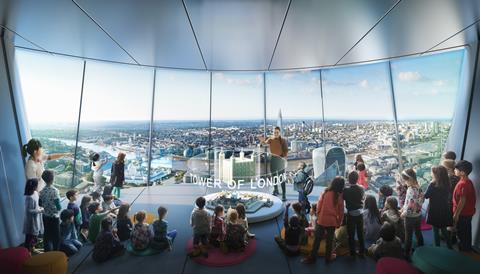City of London officials recommend approval for ‘bold and striking’ tourist attraction
Foster + Partners’ controversial Tulip tourist attraction is being recommended for approval – despite objections over its impact on the grade I-listed Tower of London and the City of London’s narrow streets.
Papers published ahead of next week’s meeting of the City of London’s planning and transportation committee urge the corporation’s decision makers to approve the 305m scheme, arguing that its advantages outweigh its impacts and that its “bold and striking” design is iconic.
In addition to Historic England, Tower of London manager Historic Royal Palaces, the mayor of London Sadiq Khan, the Bevis Marks Synagogue and Tower Hamlets council have voiced concerns over the tower – which is earmarked for a site next to the architect’s Gherkin and expected to attract 1.2m visitors a year.
The City’s own built environment team raised concerns about the scheme’s impact at ground level in particular its entrance pavilion’s ability to handle the number of people queuing to make use of its 12 floors of visitor attractions, which include bars, restaurants and revolving “pods”.

But in a 152-page report, planning officers said they believed that while the proposals – created for the billionaire Gherkin owner Jacob J Safra – would breach some City of London planning policies, they would cause “less than substantial harm” to the setting of the Tower of London.
Harm judged “less than substantial” is an important consideration in the government’s National Planning Policy Framework.
“Virtually no major development proposal is in complete compliance with all policies and in arriving at a decision it is necessary to assess all the policies and proposals in the plan and to come to a view as to whether in the light of the whole plan the proposal does or does not accord with it,” officers said.
Recommending the Tulip for approval, they said Fosters’ design was “highly unusual and unique within the UK context” meaning that the tower had “the potential to become an architectural icon for the City, London and the UK”, and further afield.
“The proposed architectural approach is bold and striking. Its aesthetic inspiration derives from the Gherkin and the proposal seeks to achieve a familial synergy with the Gherkin,” officers said.
They added: “London is inherently an innovative and ever-changing City. The Tulip as an architectural expression could continue this tradition of accommodating unconventional and eye-catching landmarks on the skyline, although this needs to be balanced against its impact on other historical landmarks.”
Last month, the chair of the City’s planning and transportation committee Chris Hayward told Building he expected that any decision to approve the Tulip would be called in for further scrutiny at a public inquiry presided over by a planning inspector.
Other firms working on the plans include Gherkin builder Skanska and consultant Alinea.
The City’s planning and transportation committee meets to determine the Tulip proposal at 10.30 am on 2 April.



























No comments yet